SLIS132A October 2008 – March 2015 TPS55065-Q1
PRODUCTION DATA.
- 1 Features
- 2 Applications
- 3 Description
- 4 Revision History
- 5 Pin Configuration and Functions
- 6 Specifications
-
7 Detailed Description
- 7.1 Overview
- 7.2 Functional Block Diagram
- 7.3
Feature Description
- 7.3.1 Switched-Mode Input/Output Terminals (L1, L2)
- 7.3.2 Supply Terminal (Vdriver)
- 7.3.3 Internal Supply Decoupling Terminal (Vlogic)
- 7.3.4 Input Voltage Monitoring Terminal (AIN)
- 7.3.5 Input Undervoltage Alarm Terminal (AOUT)
- 7.3.6 Reset Delay Timer Terminal (REST)
- 7.3.7 Reset Terminal (RESET)
- 7.3.8 Main Regulator Output Terminal (VOUT)
- 7.3.9 Low-Power-Mode Terminal (CLP)
- 7.3.10 Switch-Output Terminal (5Vg)
- 7.3.11 5Vg-Enable Terminal (5Vg_ENABLE)
- 7.3.12 Slew-Rate Control Terminals (SCR0, SCR1)
- 7.3.13 Modulator Frequency Setting (Terminal Rmod)
- 7.3.14 Ground Terminal (PGND)
- 7.3.15 Enable Terminal (ENABLE)
- 7.3.16 Bootstrap Terminals (CBOOT1 and CBOOT2)
- 7.4 Device Functional Modes
- 8 Application and Implementation
- 9 Power Supply Recommendations
- 10Layout
- 11Device and Documentation Support
- 12Mechanical, Packaging, and Orderable Information
Package Options
Mechanical Data (Package|Pins)
- PWP|20
Thermal pad, mechanical data (Package|Pins)
- PWP|20
Orderable Information
6 Specifications
6.1 Absolute Maximum Ratings
over operating free-air temperature range (unless otherwise noted) (1)| MIN | MAX | UNIT | ||
|---|---|---|---|---|
| V(driver)(2) | Unregulated input voltage, | –0.5 | 40 | V |
| V(AIN), V(ENABLE)(2) | Unregulated inputs | –0.5 | 40 | V |
| V(Cboot1) | Bootstrap voltages | 52 | V | |
| V(Cboot2) | 14 | V | ||
| V(L1) | Switch mode voltages | –1 | 40 | V |
| V(L2) | –1 | 7 | V | |
| V(Rmod),V(SCR0),V(SCR1),V(CLP), and V(5Vg_ENABLE) (2) | Logic input voltages | –0.5 | 7 | V |
| V(RESET),V(AOUT),V(logic), and V(REST)(2) | Low output voltages | –0.5 | 7 | V |
| PD | Continuous power dissipation | SeeDissipation Ratings | ||
| TJ | Operating virtual junction temperature | –40 | 150 | °C |
| TA | Operating ambient temperature | –40 | 125 | °C |
| Tstg | Storage temperature | –65 | 125 | °C |
(1) Stresses beyond those listed under Absolute Maximum Ratings may cause permanent damage to the device. These are stress ratings only, which do not imply functional operation of the device at these or any other conditions beyond those indicated under Recommended Operating Conditions. Exposure to absolute-maximum-rated conditions for extended periods may affect device reliability.
(2) All voltage values are with respect to ground.
6.2 ESD Ratings
| VALUE | UNIT | |||||
|---|---|---|---|---|---|---|
| V(ESD) | Electrostatic discharge | Human body model (HBM), per AEC Q100-002(1)(2) | Classification 1B for pin 7, pin 8, pin 9 | ±800 | V | |
| Classification 2 for pins 1 to 6 and 10 to 20 | ±2000 | |||||
| Charged device model (CDM), per AEC Q100-011 | Classification Level C4B for All pins | ±750 | ||||
(1) AEC Q100-002 indicates HBM stressing is done in accordance with the ANSI/ESDA/JEDEC JS-001 specification.
(2) The human body model is a 100-pF capacitor discharged through a 1.5-kΩ resistor into each terminal.
6.3 Recommended Operating Conditions
| MIN | NOM | MAX | UNIT | ||
|---|---|---|---|---|---|
| Unregulated input voltage, V(driver) | 6 | 24 | V | ||
| Unregulated input voltages, V(AIN) and V(ENABLE) | 0 | 24 | V | ||
| Switched-mode terminals | V(L1) | –1 | 17 | V | |
| V(L2) | 5 | 5.5 | |||
| Bootstrap voltages | V(Cboot1) | V(driver) + 10 | V | ||
| V(Cboot2) | 8 | ||||
| Logic levels (I/O), V(Rmod), V(logic),V(SCR0),V(SCR1),V(5Vg_ENABLE),V(RESET), V(AOUT), V(CLP), and V(REST) | 0 | 5.25 | V | ||
| Operating ambient temperature range, TA | –40 | 125 | °C | ||
| Logic levels (I/O), V(SCR0), V(SCR1), V(CLP) directly connected to V(logic) | V(logic) | V(logic) | V | ||
6.4 Thermal Information
| THERMAL METRIC(1) | TPS55065-Q1 | UNIT | |
|---|---|---|---|
| PWP [HTSSOP] | |||
| 20 PINS | |||
| RθJA | Junction-to-ambient thermal resistance | 37.9 | °C/W |
| RθJC(top) | Junction-to-case (top) thermal resistance | 22.7 | |
| RθJB | Junction-to-board thermal resistance | 20.2 | |
| ψJT | Junction-to-top characterization parameter | 0.7 | |
| ψJB | Junction-to-board characterization parameter | 19.9 | |
| RθJC(bot) | Junction-to-case (bottom) thermal resistance | 1.8 | |
(1) For more information about traditional and new thermal metrics, see the IC Package Thermal Metrics application report, SPRA953.
6.5 Dissipation Ratings
| RθJA | POWER RATING TA ≤ 25°C |
DERATING FACTOR ABOVE TA = 25°C |
POWER RATING TA = 85°C |
POWER RATING TA = 125°C |
|---|---|---|---|---|
| 32°C/W | 3.9 W | 31.25 mW/°C | 2.03 W | 0.781 W |
| 40°C/W | 3.125 W | 25 mW/°C | 1.625 W | 0.625 W |
6.6 Electrical Characteristics
V(driver) = 6 V to 17 V, TA = -40°C to 125°C, unless otherwise noted| PARAMETER | TEST CONDITIONS | MIN | TYP | MAX | UNIT | |
|---|---|---|---|---|---|---|
| V(driver) | Unregulated input voltage | 1.5 | 40 | V | ||
| V(driver) | Start-up condition voltage | IO = 500 mA | 5 | V | ||
| SOM | Soft-start ramp | CO = 36 μF (minimum) to 220 μF (maximum) | 4 | 20 | V/ms | |
| CO = 220 μF (min) to 470 μF (max), see Note (1) | 2 | 20 | ||||
| I(standby) | Standby current | ENABLE = low | 10 | 20 | μA | |
| Iq | Quiescent current | CLP = 0 V, V(driver) = 11 V, IO = 0 mA | 100 | 160 | μA | |
| VO | Output voltage | DC | 5 | V | ||
| VO | Output-voltage tolerance | Normal mode | 2% | |||
| Boost/buck crossover or low-power mode | 3% | |||||
| IO | Output current | V(driver) ≥ 7 V | 0.5 | A | ||
| IO(Boost) | Output current, boost mode | V(driver) = 2 V, see Note (2) | 200 | mA | ||
| V(driver)= 1.5 V, see Note (2) | 120 | |||||
| IPPn | Internal peak current limit (normal mode) | See (1) | 1.75 | 2.5 | A | |
| IPPl | Internal peak current limit (low-power mode) | See (1) | 0.75 | 1.25 | A | |
| IP | Peak current | V(driver) = 16 V, IO = 500 mA, L = 33 μH | 1.5 | A | ||
| V(driver) | Boost/buck crossover voltage window | See (3) | 5 | 5.9 | V | |
| Tot | Thermal shutdown(4) | 160 | 180 | 200 | °C | |
| 5Vg OUTPUT AND ENABLE | ||||||
| rDS(on) | On-state resistance | 135 | 225 | mΩ | ||
| IO | Output current | 400 | mA | |||
| VI | 5Vg_ENABLE input-voltage range | –0.5 | VO | V | ||
| VIH | 5Vg_ENABLE threshold high voltage | V(5Vg) = 5 V | 2.5 | 3 | 3.5 | V |
| VIL | 5Vg_ENABLE threshold low voltage | V(5Vg) = 0 V | 1.5 | 2 | 2.5 | V |
| V(hys) | Hysteresis voltage | 0.5 | 1 | V | ||
| r(pd) | Internal pulldown resistor | 300 | 500 | 850 | kΩ | |
| ENABLE | ||||||
| VI | ENABLE input-voltage range | –0.5 | 40 | V | ||
| VIH | ENABLE threshold high voltage | 8 V ≤ V(driver) ≤ 17 V | 2.5 | 3 | 3.5 | V |
| 6 V ≤ V(driver) < 8 V | 1.9 | 3 | 3.5 | |||
| VIL | ENABLE threshold low voltage | VO = 5 V | 1.5 | 2 | 2.5 | V |
| V(hys) | Hysteresis voltage | 8 V ≤ V(driver) ≤ 17 V | 0.5 | 1 | V | |
| 6 V ≤ V(driver) < 8 V | 0.1 | |||||
| RESET | ||||||
| V(th) | RESET threshold voltage | 4.51 | 4.65 | 4.79 | V | |
| V(RESET) | RESET tolerance | 3% | ||||
| t(RESET) | RESET time | C(REST) = 10 nF | 8 | 10 | 12 | ms |
| C(REST) = 100 nF, see (1) | 80 | 100 | 120 | |||
| VOL | RESET output low voltage | Isink = 5 mA | 450 | mV | ||
| Isink = 1 mA | 84 | |||||
| t(deglitch) | RESET deglitch time | See (1) | 8 | 10 | 12.5 | μs |
| ALARM | ||||||
| VI | Alarm input-voltage range | –0.5 | 40 | V | ||
| VIL | Alarm threshold low voltage | 2.2 | 2.3 | 2.35 | V | |
| VIH | Alarm threshold high voltage | 2.43 | 2.5 | 2.58 | V | |
| V(hys) | Hysteresis voltage | 200 | mV | |||
| VOL | Alarm output low voltage | Isink = 5 mA | 450 | mV | ||
| Isink = 1 mA | 84 | |||||
| LOW-POWER MODE (PULSE MODE) PFM | ||||||
| IO(LPM) | Load current in low-power mode | V(driver) < 7 V | 50 | mA | ||
| II(avg) | Average input current | V(driver) = 11 V, IO = 5 mA, CLP = low | 3.55 | mA | ||
| VO | Output-voltage tolerance | VO = 5 V | 2.4% | 3% | ||
| DIGITAL LOW-POWER MODE (CLP) | ||||||
| VIH | High-level CLP input threshold voltage | Normal mode | 2.6 | V | ||
| VIL | Low-level CLP input threshold voltage | Low-power mode | 1.15 | V | ||
(1) Ensured by characterization.
(2) Tested with inductor having following characteristics: L = 33 μH, Rmax = 0.1 Ω, IR = 1.8 A. Output current must be verified in application when inductor Rmax (ESR) is increased.
(3) Ensured by characterization. For further details, see Buck/Boost Transitioning.
(4) Ensured by characterization; hysteresis 15°C (typical)
6.7 Switching Characteristics
over operating free-air temperature range (unless otherwise noted)| PARAMETER | TEST CONDITIONS | MIN | TYP | MAX | UNIT | |
|---|---|---|---|---|---|---|
| f(sw) | Switching frequency | V(Rmod) = 0 V, modulator OFF | 440 | kHz | ||
| f(sw)ac | Operating-frequency accuracy | f(sw) = 440 kHz | 20% | |||
| f(sw)min | Modulation minimum frequency | 270 | 330 | 445 | kHz | |
| f(sw)max | Modulation maximum frequency | 450 | 550 | 680 | kHz | |
| f(mod)span | Modulation span | 220 | kHz | |||
| f(mod) | Modulation frequency | Rmod = 12 kΩ ±1% | 28 | kHz | ||
| f(mod)ac | Modulation-frequency accuracy | 12% | ||||
6.8 Typical Characteristics
(Reference L1 Terminal, see Figure 8 through Figure 10)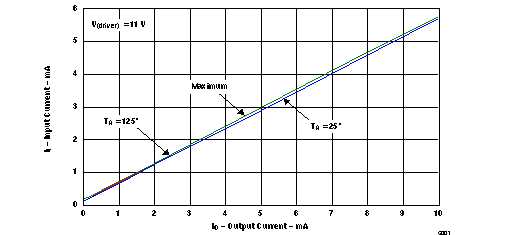
| Maximum characteristic specified by design. | ||
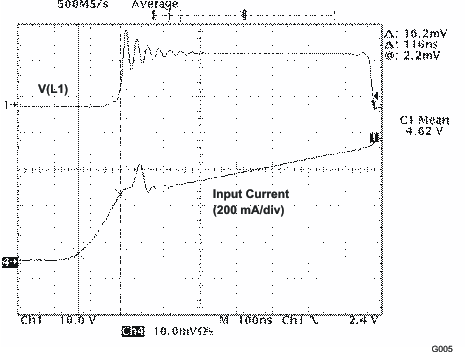
SCR1 = 0, Input-Current Slew Rate = 2.8 A/µs, IL = 500 mA,
V(driver) = 15 V
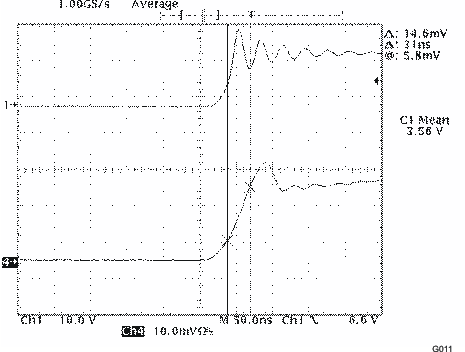
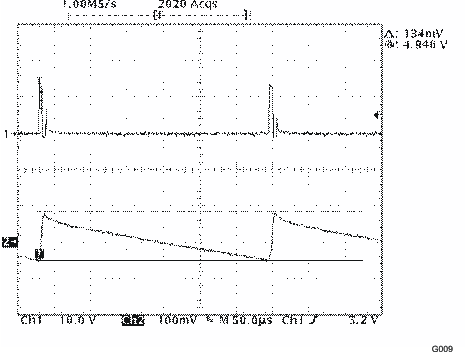
CO = 47 µF
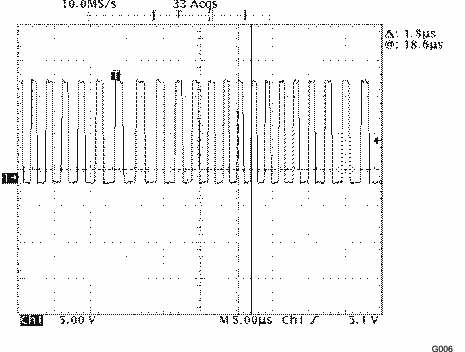
With Modulation Enabled, Rmod = 12 kΩ, IL = 200 mA
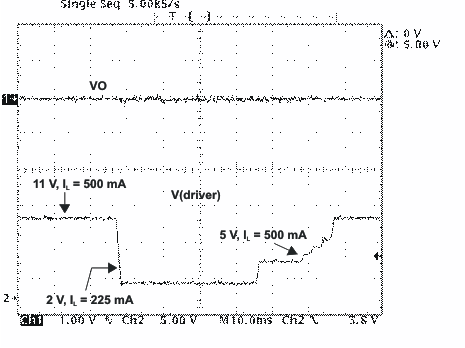
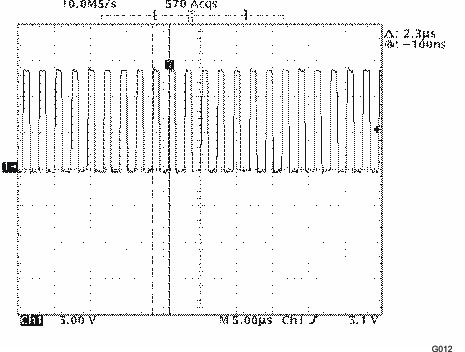
(446 kHz) With Modulation Function Disabled, IL = 200 mA
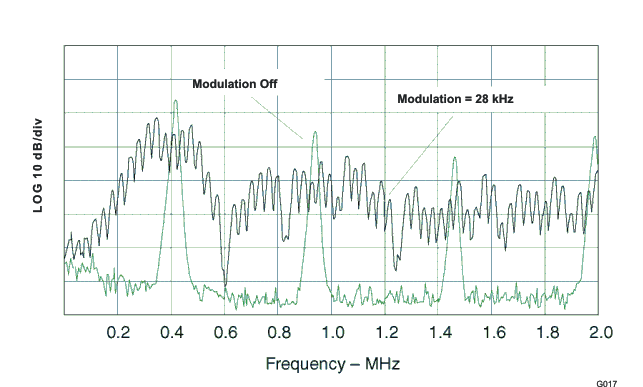
| These values represent conducted EMI results of a test board for display purposes only. Actual results may vary greatly depending on board layout and external components and must be verified in actual application. |
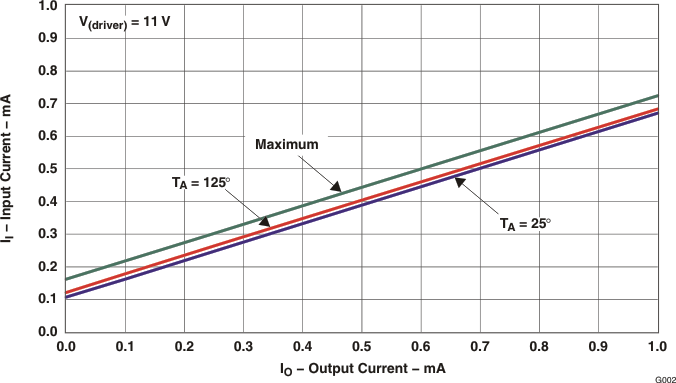
| Maximum characteristic specified by design. | ||
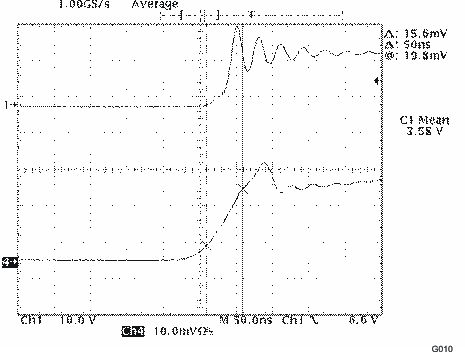
SCR0 = 1, Input-Current Slew Rate = 6.25 A/µs,
IL = 500 mA, V(driver) = 15 V
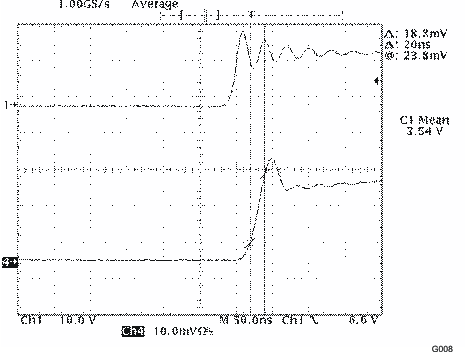
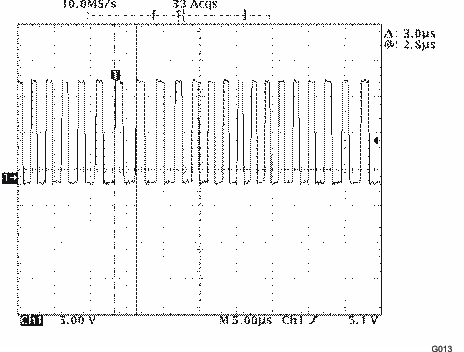
with Modulation Enabled, Rmod = 12 kΩ, IL = 200 mA
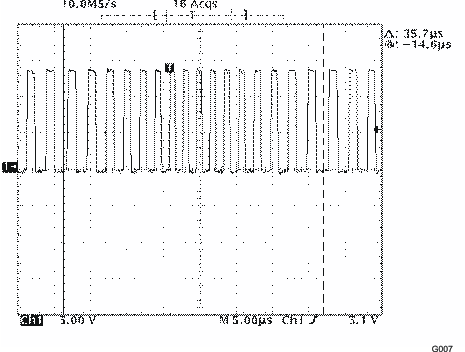
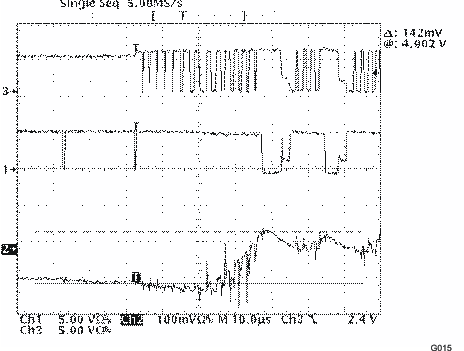
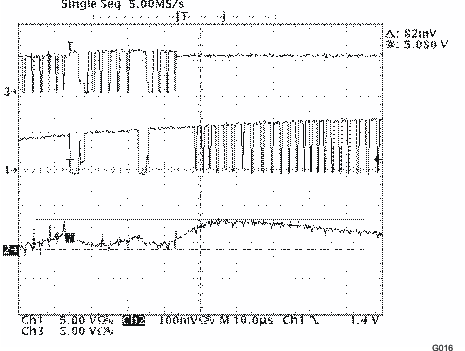
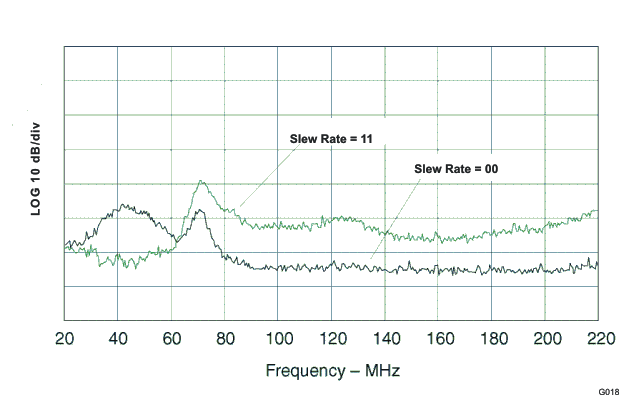
| These values represent conducted EMI results of a test board for display purposes only. Actual results may vary greatly depending on board layout and external components and must be verified in actual application. |